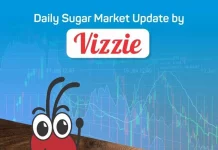Extremely deteriorated macro scenario
The sugar market in NY closed out Friday at 44 points down (almost 10 dollars per ton) against the previous week. The futures contract for July/2022 closed out at 18.84 cents per pound, reflecting the uncertainties that hover over the possible effects of a change in the ICMS on fuels (read more below). In fact, NY behaved pretty moodily during the week.
The Center-South 2022/2023 crop is behaving like we had predicted. World product supply without frights; Brazil short and fixed by more than 20 million tons, but uncertain about whether it will increase sugar production due to changes in price policy; India dumping more than 10 million tons of sugar and wanting to export more and – it couldn’t be different – inflation and interest rates discouraging industrial consumers to rebuild their inventories. So, the pressure on shorter months is growing and the carry today is already pointing to a cost of 5% per year.
The non-indexed funds still keeping a long position on the sugar futures market in NY – whose price went up 0% this year – is unprecedented. How much longer the speculative funds will keep these 113,000 lots (last Tuesday’s position) is a good question. But the main issue is who will provide liquidity (buying) when they decide to settle their positions (selling)? That’s where the actual risk lies – one that can be strengthened with the worsening of the political situation in pre-election Brazil and knock down the real, which traded at R$5.0127 this Friday and can – depending on the size of the crisis – hit R$5.6000 by September. Think about a confusing scenario…
Regardless of the outcome of this incredible mess caused by the federal government about the changes in fuel taxation, the level of uncertainty among the decision makers inside the mills has reached its peak. Capitalized mills – due to the ambiguities on the horizon, especially considering that if the project passes, it expires on the last day of the year, at the start of a new administration – choose to leave as much ethanol as possible in the tank and wait for the events of the New Year. It’s worth taking the risk.
First of all, presumably the shot in the foot the federal government will give itself in its obsessive search of being reelected is bound to cause a fuel shortage, especially diesel that today – according to market rumors – has a stock to last a little longer than a week. This is a point of greatest risk all along the agro-business chain.
The government is unsuccessfully trying to sugar coat it. It’s unquestionable that – only in this year’s accumulated – gas has gone up 89% on the foreign market, diesel has gone up 88%, type WTI oil has gone up 60% and type Brent oil (that serves as reference to Petrobras) has gone up 57%. Brazil’s situation would be even worse if the Brazilian currency hadn’t appreciated a little over 10% against the dollar in the 2022 accumulated.
Based on Friday’s prices, the difference between Petrobras price and the foreign market was already above R$1.2600 per liter at the refinery. When this damming blows up at some point, all the effort the government has made will have been to no avail.
What the market expects is that the bill limiting the ICMS to 17 or 18% depending on the state passes. In addition to it, there is an Amendment Proposal to the Constitution that creates a tax differential between fossil and renewable fuel for 20 years, bringing safety to the sugar-alcohol sector. However, there are still issues to be discussed about hydrous and diesel exemption and the different fiscal treatment for each product when we are dealing with a producer state or a consumer state. But this is all open to lawsuits on the part of states that feel jeopardized.
With so many unknowns to be figured out, hedgers (mills, food industries, and sugar and fuel traders, among others) must be careful right now. As far as we are concerned, it’s worth thinking about the unthinkable, that is, about a market rupture that will cause a sharp price fall (exogenous factors – Chinese lockdown, deterioration of the global economic picture, for example, and domestically, a political crisis that can push up the dollar value). Therefore, maybe it’s worth thinking about buying a sugar put at an exercise price of about 16 cents per pound and maturing in March/2023 so we can sleep peacefully before the elections in October.
To read the previous episodes of World Sugar Market – Weekly Comment, click here
To get in touch with Mr. Arnaldo, write on arnaldo@archerconsulting.com.br












